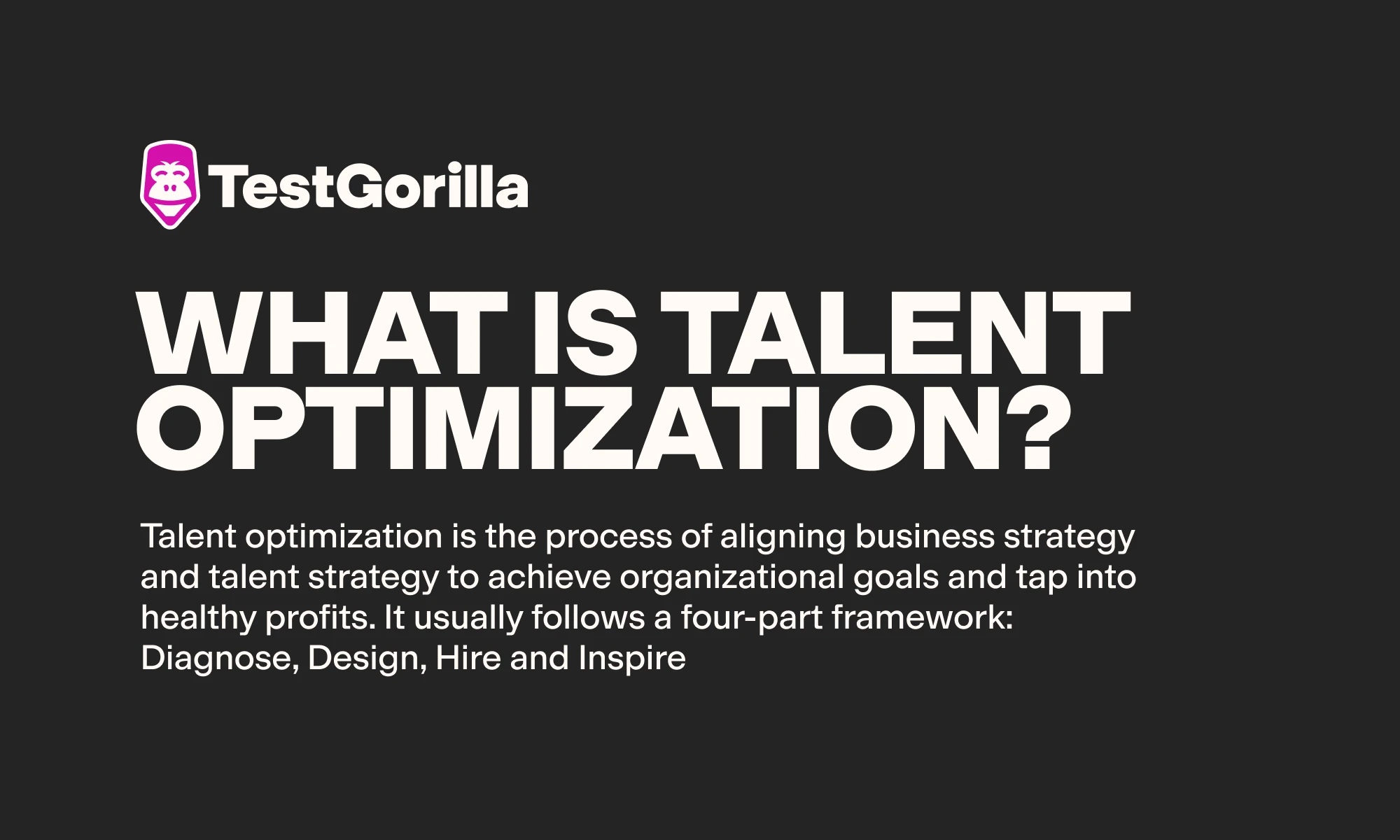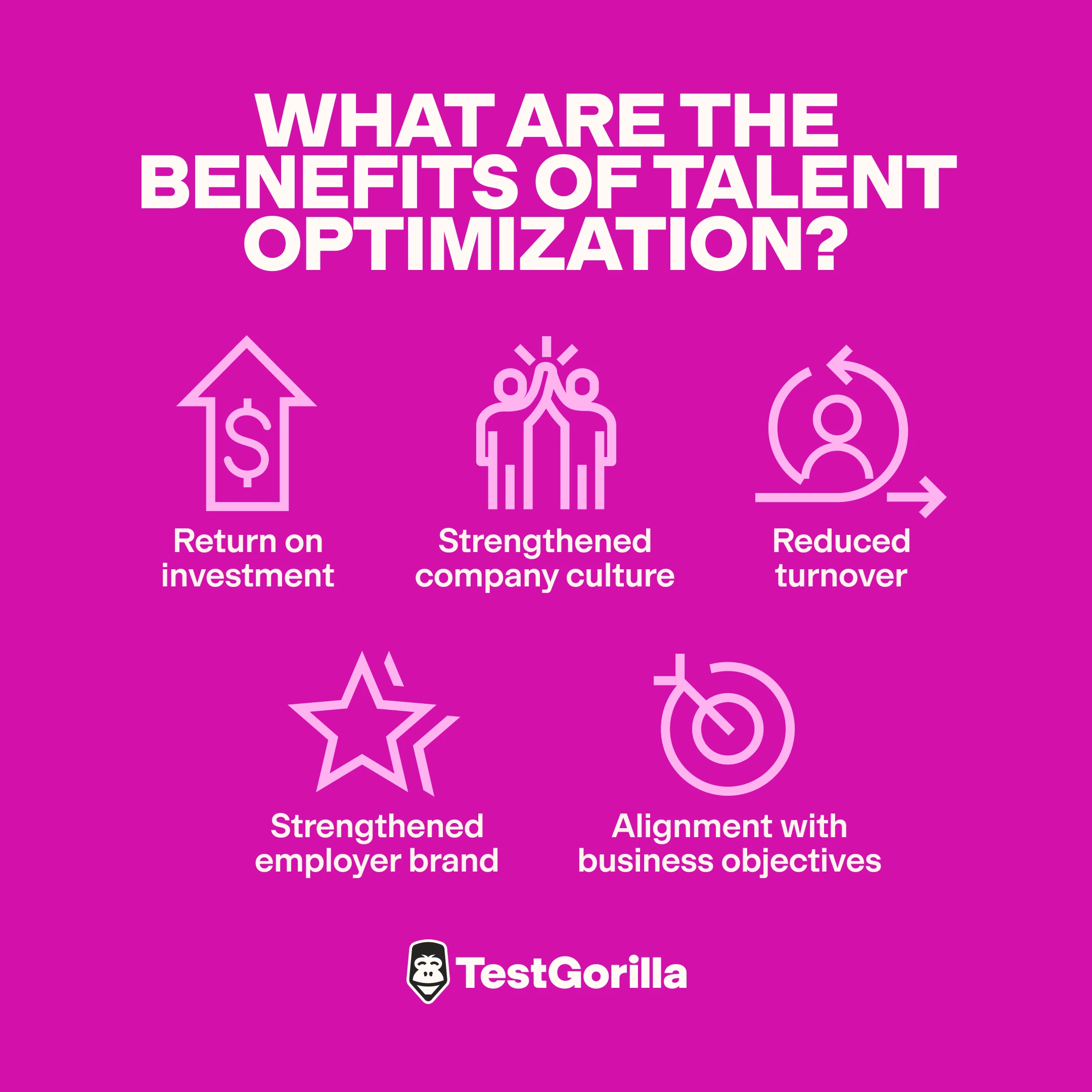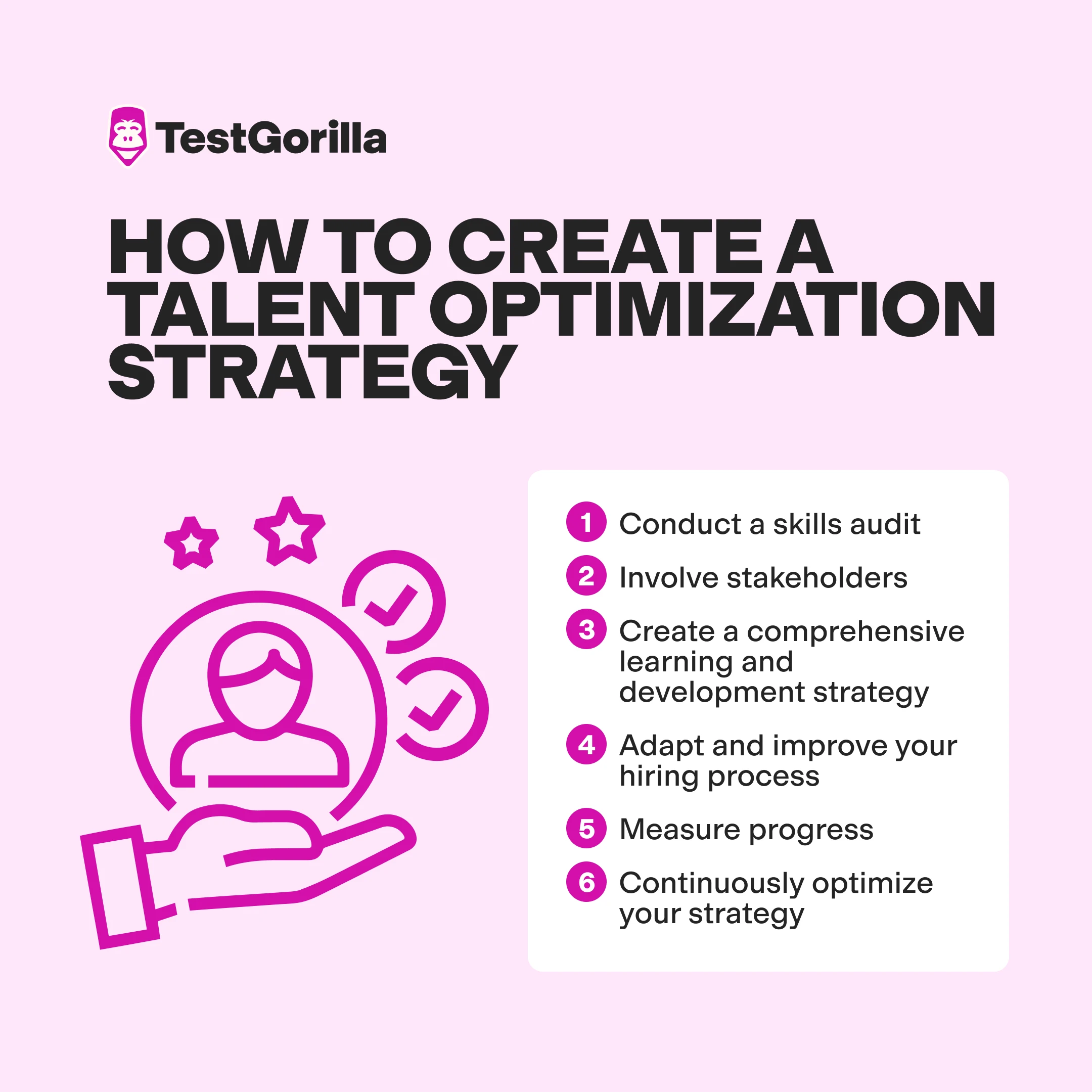Your business strategy may perfectly align with organizational objectives, and you may have all the fancy tools and systems in the world. However, without the right people on the ground making it work, your business will flounder.
That’s where talent optimization comes in – it’s all about going beyond the basics of recruitment and building a people strategy that drives real results. This guide covers everything you need to know about talent optimization: what it is, its benefits, how to create a talent optimization strategy, and some common pitfalls to watch out for along the way.
Key takeaways
Talent optimization is the process of aligning your business strategy and talent strategy to turbocharge your organization’s success.
Talent optimization ensures you have the right people with the right skills in the right jobs to get the maximum return on your initial recruitment investment.
The benefits of talent optimization include reduced turnover and strengthened company culture and employer brand.
Implementing talent optimization includes conducting a skills audit, engaging stakeholders, crafting a learning and development strategy, and measuring your progress using data.
What is talent optimization?
Talent optimization is the process of aligning business strategy and talent strategy to achieve organizational goals and tap into healthy profits. It ensures you have the right people in the right jobs with the right skills to maximize your chance of hitting business targets.
Talent optimization usually follows a four-part framework:
1. Diagnose
Diagnosing is all about identifying the current issues in your organization through data channels. You should regularly monitor employee engagement surveys, feedback from one-to-ones with managers, and performance metrics to get a clear picture of what’s working and what’s not.
2. Design
Once you’ve pinpointed the issue, it’s time to design a solution. The solution will depend on what you’re hoping to achieve, the resources available to you, and the specific needs of your team. It could mean restructuring a department, hiring new talent, or mixing up your training programs. The goal here is to look at the long term; don’t opt for a quick fix.
3. Hire
The next step is to hire talent that aligns with your new solution. You might be looking for people with a specific qualification or skill set to fill any gaps you’ve identified, or you may just require more people power to drive your new strategy. Either way, hiring candidates that align with business needs is crucial.
Pro tip: Don’t forget about internal hires. Supporting and training internal hires can be just as effective at filling skills gaps and saving the business a ton of money. For example, did you know it’s 1.7 times more expensive to recruit externally than to hire internally?
4. Inspire
The final step is to inspire your team. This is all about creating an environment where your team feels valued, supported, and motivated. Continually check in and collect feedback via measured conversations and employee feedback surveys. This data may reveal gaps in your culture you hadn’t previously recognized.
Remember: talent optimization isn’t one-and-done. It’s a continual improvement process to ensure your talent strategy aligns with your business strategy.
Talent optimization in practice
Check out this example of how talent optimization can work in practice:
After analyzing your Diversity and Inclusivity metrics, you discover that your organization is almost 75% men. You do some digging and find that 80% of female colleagues don’t return to work after completing their maternity leave. Your business offers a generous maternity leave package, so what could be going wrong?
The first step is to diagnose. You need to collect data from colleagues who did decide to return after maternity leave to get their side of the story. What made them return, did they have any doubts, and can they offer insight into why colleagues aren’t returning?
You may find that you don’t provide adequate flexible working support, the workload is too high for those juggling a new family, or that new parents don’t feel supported by managers after they return.
Once you’ve uncovered this data, it’s time to design a solution. This could be improving your flexible working policy, offering subsidized childcare options, or training managers on supporting new parents in the workplace.
If your solution exposes a skills gap, then your next step is to hire. This doesn’t necessarily mean hiring externally; you can seek skilled individuals within the organization – for instance, by asking situation-based questions about supporting new parents in returning to work. Importantly, you should set up training programs for current team members to close the skills gap.
Finally, inspire. Create a focus group for returning parents to check how your new measures are landing. Do they feel supported, motivated, and valued? Collect data on how these changes impact employee retention and overall engagement with female workers aged between 18 and 40 (roughly). This portion of the framework should be a continual process.
The best insights on HR and recruitment, delivered to your inbox.
Biweekly updates. No spam. Unsubscribe any time.
What are the benefits of talent optimization?
Talent optimization has a multitude of benefits when implemented correctly. These include:
Return on investment: The average cost of hiring a new employee is around $4,700, so naturally, businesses will want to recoup that expense. Talent optimization ensures you’re hiring the right people with the right skills for the right roles, maximizing the value each employee brings to the table.
Strengthened company culture: Hiring people who buy into your company’s mission, values, and goals helps build a strong company culture. Positive cultural alignment leads to improved employee motivation, collaboration, and productivity.
Reduced turnover: Did you know employees are 21% less likely to leave a business if offered supportive learning opportunities than those who aren’t? Therefore, investing in your people means increased retention rates and cost savings for your business.
Strengthened employer brand: Talent optimization helps position your company as an employer of choice. When you prioritize your employees – through meaningful roles, growth opportunities, and a strong company culture – you build a reputation as a great workplace. This makes it easier to attract top talent and stand out from competitors.
Alignment with business objectives: Aligning business and people goals ensures everyone in the organization is working toward the same vision. When everyone sings from the same hymn sheet, it turbocharges efforts, helping the business achieve its objectives faster and more efficiently.
How to create and implement a talent optimization strategy
Ready to learn how to craft your own talent optimization strategy? Read on for your step-by-step guide.
1. Conduct a skills audit
Your first priority should be creating a skills audit to determine what abilities you already have in your organization. This skills audit gives you a clear picture of your team's current strengths and will highlight any gaps.
Gather information on individual and team performance and keep tabs on whether everyone is achieving their goals, upgrading their skills, and expanding their knowledge. This continuous data feed will help you monitor whether the business is working towards its goals and targets and ready to adapt to new challenges.
Some of the datasets you want to collect regularly include:
Employee engagement: Whether or not employees enjoy their work and how that affects them, their teams, and the organization as a whole.
Job performance: How well employees are achieving their goals and showing positive results. Use your business strategy as the focal point for measuring job performance.
Organizational culture. How well do employees match the culture of your organization, and how does that affect their values and norms? Culture is a vital aspect of talent optimization, and if it’s not embodied by everyone, there’s a risk of your strategy not working.
Use performance management tools to collect this information. Job satisfaction surveys, 360-degree feedback reviews, one-on-one interviews, and coaching sessions offer valuable insights into how your team is performing, thinking, and feeling.
You can also use skills testing to measure the current skill level of your employees. Collecting this objective data will give a great overview of where your team currently stands and what development opportunities might be needed.
It’s also worth gathering data on applicants interested in joining your organization. Besides collecting work history, education, knowledge, and skills data, you should also try to collect information about their behavior, cognitive abilities, values, ability to work well individually and in a team, and their personality and culture add. This way, you have an applicant pool to tap into should you need to fill any skills gaps.
2. Involve stakeholders
Once you’ve conducted and analyzed your skills audit and pinpointed any gaps, you need to present the data to your stakeholders.
Your company’s leadership should be on board with the process for talent optimization to work. Although this is your strategy, your management teams will be the ones making the changes and providing feedback, so it’s important they’re aligned.
Management can share specific insights into how their teams and individual employees work that you might not be able to gain on your own. Collaborating with stakeholders not only rallies their support but also creates a sense of shared ownership, making it more likely that changes will be implemented effectively.
For example, part of your inspire step could be to hold regular listening sessions with managers to gather their feedback on the current process.
3. Create a comprehensive learning and development strategy
Once everyone is on board with talent optimization, you have the data, and you know what the solution entails, you can start taking action.
One of the first steps will be to implement a solid learning and development (L&D) strategy. L&D is the backbone of any successful talent optimization effort and, ultimately, any successful organization. It ensures your employees have the skills and knowledge they need to do their best while equipping them to meet future business goals.
If the resources are available, you can even hire an external firm to provide coaching sessions and unbiased feedback. These methods will improve not only your work metrics but also your employees’ satisfaction and motivation. Actively helping and developing your staff will keep your retention rates high.
4. Adapt and improve your hiring process
Since you’ve identified the gaps within your organization, you can now focus on hiring people with the right skills and attributes. This way, you won’t need to create specific training sessions and can employ only those who meet your requirements.
Skills testing is your secret weapon here. Adapt your processes to take a skills-based hiring approach. This way, you can directly target the skills gaps affecting business goals. The 2024 skills-based hiring report found that this approach reduced the time to hire for 86% of businesses, improved diversity for 90%, and improved retention for 91%.
However, to stay competitive, even your most talented employees will need additional training at some point. Your business will always be facing new changes, so remember to upgrade your methods and improve training continuously.
5. Measure progress
Monitor how individual employees and teams are progressing after you have given them extra training. You can measure employees’ success by mapping goals and seeing whether or not they’re achieving them.
These goals should be SMART – Specific, Measurable, Achievable, Relevant, and within a set Time period. For example, “increase sales” isn’t a SMART goal, even though it might be relevant to the individual. However, “increase sales by 10% by the end of the quarter” is a SMART goal.
If your team is meeting its goals, then your talent optimization strategy is working. If they aren’t, you may need to tweak the strategy to ensure you get the right results. This could be as simple as adapting training sessions to match learning styles or breaking them down into extra sessions.
6. Continuously optimize your strategy
Measuring progress at regular intervals (every six months to a year) is a good way to ensure you’re moving in the right direction.
Remember that competing firms will also be running a similar scheme, so you want to constantly improve and adjust your methods to get the best results.
With time, you’ll understand what works and what doesn’t. As you remove less successful methods and add more effective ones, you’ll enhance your talent optimization strategy, making the process more efficient and productive.
The challenges of talent optimization
Creating a talent optimization strategy for your company has immense benefits. However, as with any process, there are some drawbacks.
1. It can be a lengthy process
To have a successful talent optimization strategy, you’ll need to invest time and resources and have the patience to wait for results.
It will take time to implement the strategy, integrate it within all departments, and get everyone on board.
As an HR leader, you’ll have to approach teams and individuals to understand what their requirements are, what skills need developing, and the best ways to aid them.
This can be time-consuming. Talent optimization isn’t something that’s going to happen overnight. But it’s worth the investment. Remind your teams to be patient and understanding during this process. Otherwise, they may feel disheartened if results don’t come straight away.
2. Make sure you have the right data
Without the proper data, you won’t succeed in implementing your talent optimization strategy. For instance, if you’re working with outdated or inaccurate data, your decisions will be based on a fictitious scenario rather than the real picture.
It’s best to use a systematic, objective approach to collecting data since you’ll be measuring progress and optimizing your strategy continually.
Consider using skills assessments, performance reviews, or employee surveys. This will give you a clearer picture of your workforce's strengths, weaknesses, and potential gaps on which to base your decisions.
3. Leadership support is essential
A critical aspect of the talent optimization process is receiving the support of your leadership.
If you don’t get management positions on board with your talent optimization strategy, the whole process will be ineffective (since it’s down to them to implement the changes).
Put in consistent time with higher-ups to discuss aligning business goals and talent strategies. Present your findings from the skills audit and outline the gaps.
Use TestGorilla to futureproof your organization and empower your employees
To succeed in today’s business world, you need to leverage talent optimization. This intersection of business and talent strategy is your secret weapon to help your business grow, refine its processes, and beat the competition. However, you can’t just set it and forget it. Talent optimization is an ongoing process that requires regular assessment, adaptation, and commitment.
As part of your strategy, use TestGorilla’s skills tests to measure your employees’ capabilities, identify skills gaps, and pinpoint growth opportunities. Furthermore, improve your hiring process to find and hire top talent from the get-go. Make informed, bias-free hiring decisions with TestGorilla today. Schedule a free demo or sign up for a free TestGorilla account.
You've scrolled this far
Why not try TestGorilla for free, and see what happens when you put skills first.

















